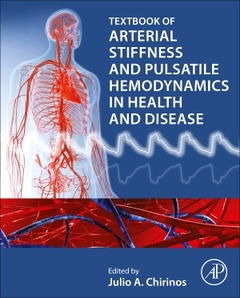Arterial Stiffness and Pulsatile Hemodynamics in Health and Disease
Coordonnateur : Chirinos Julio A.

Most biology-oriented books misinterpret the physiology of arterial stiffness and pulsatile arterial hemodynamics based on physics. A proper understanding of the field requires both biologic/clinical and biophysical/bioengineering knowledge which Arterial Stiffness and Pulsatile Hemodynamics in Health and Disease provides in a comprehensive yet simplified manner. The resource is organized into five parts covering principles, physiology, biologic pathways, clinical implications and therapeutics and provides a thorough overview of the field, presenting complex engineering concepts in a way that those in science and medicine can more easily understand.
Arterial Stiffness and Pulsatile Hemodynamics in Health and Disease includes detailed illustrations, animations and slide shows. Additionally, advanced bioengineering concepts presented in boxes for the reader who wants more in-depth biophysical knowledge. This is a must-have reference for students, researchers and clinicians interested in learning more about this field.
- Provides a comprehensive review of the clinical implications of arterial stiffness and pulsatile hemodynamics and its role in human disease
- Incorporates case studies and calculations/worked examples with mathematical principles explained in a conceptual manner without complicated formulas
- Features chapter contributions from leading international researchers and clinicians
SECTION I. Biophysical and Technical Principles 1. Basic Principles of pulsatile pressure and flow phenomena in elastic vessels 2. Measurements of arterial pressure and flow in vivo 3. Essential Principles of Pulsatile Pressure-flow relations 4. Arterial wall stiffness: basic principles and methods of measurement 5. Devices to measure arterial stiffness 6. Ambulatory measurements of arterial stiffness and pulsatile hemodynamics
Section II. Basic and Applied Physiology 7. The microcirculation 8. Basic Ventricular and myocardial physiology 9. Hemodynamic role of the Aorta 10.Wave Reflections in the arterial tres 11.Macrovascular-microvascular cross-talk 12.Pulse Wave Analysis 13.Ventricular-arterial interactions assessed in the pressure-volume plane 14.Ventricular-arterial interactions assessed via pressure-flow relations 15.Myocardial wall stress and its role in ventricular-arterial interactions 16.Hemodynamic Determinants of Myocardial Oxygen Consumption 17.Systolic-diastolic coupling 18.Pulsatile hemodynamics in the pulmonary circulation: basic physiology
Section III. Biologic pathways leading to arterial stiffness and dysfunctional pulsatile hemodynamics 19. Mechanical fatigue and elastin fracture 20. Inflammation 21. Arterial wall Calcification 22. Extracellular matrix remodeling in the arterial wall 23. Advanced glycation end-products 24. Vascular smooth muscle dysfunction 25. Endothelial dysfunction 26. Microvascular rarefaction 27. Genetic determinants of arterial stiffness 28. Circulating Biomarkers of arterial stiffness
SECTION IV. Clinical significance of arterial stiffness and pulsatile hemodynamics 29. Effects of aging: Arterial Stiffness over the life course 30. Arterial Stiffness and Pulsatile hemodynamics Systemic Hypertension 31. Arterial Stiffness and Pulsatile hemodynamics in Diabetes 32. Arterial Stiffness and Pulsatile hemodynamics in Obesity 33. Arterial Stiffness for Cardiovascular Risk Stratification in Clinical Practice 34. Role of the arterial tree in Adaptations to exercise 35. Arterial Stiffness and Pulsatile hemodynamics Heart Failure with Reduced and Preserved Ejection Fraction 36. Arterial Stiffness and Pulsatile hemodynamics in Aortic and Mitral valve disease 37. Arterial Stiffness and Pulsatile hemodynamics in Coronary Artery Disease 38. Arterial Stiffness and Pulsatile hemodynamics Renal disease 39. Arterial Stiffness and Pulsatile hemodynamics Cognitive dysfunction and dementia 40. Arterial Stiffness and Pulsatile hemodynamics in Non-Alcoholic Liver disease 41. Arterial Stiffness and Pulsatile hemodynamics in Pre-eclampsia and Eclampsia 42. Arterial Stiffness in Pediatric populations 43. Role of pulmonary arterial load in RV dysfunction and failure
SECTION V. Therapeutic approaches 44. Effects of common vasoactive drugs on pulsatile arterial hemodynamics 45. Inorganic nitrates or other Nitric oxide donors 46. Agents that prevent arterial calcification 47. Anti-fibrotic and other agents 48. Lifestyle modifications: Physical activity, diet and other interventions 49. Role of Arterial Stiffness and Hemodynamics in Personalized medicine in hypertension and other conditions 50. Therapeutic approaches to improve right ventricular load
Associate Professor of Medicine
Adjunct Faculty, Center for Magnetic Resonance and Optical Imaging
University of Pennsylvania Perelman School of Medicine
Associate Editor, Circulation: Heart Failure
Vice-President elect, North American Artery
- Provides a comprehensive review of the clinical implications of arterial stiffness and pulsatile hemodynamics and its role in human disease
- Incorporates case studies and calculations/worked examples with mathematical principles explained in a conceptual manner without complicated formulas
- Features chapter contributions from leading international researchers and clinicians
Date de parution : 09-2021
Ouvrage de 750 p.
19x23.4 cm
Disponible chez l'éditeur (délai d'approvisionnement : 14 jours).
Prix indicatif 209,76 €
Ajouter au panierMots-clés :
cardiovascular system; arterial stiffness; pulsatile hemodynamics; pulsatile pressure and flow; arterial walls; ambulatory measurements; microcirculation; ventricular physiology; myocardial physiology; aorta; wave reflections; arteries; macrovascular; microvascular; pulse wave analysis; ventricular-arterial interactions; pressure-volume; pressure-flow; myocardial wall stress; myocardial oxygen consumption; systolic-diastolic coupling; pulmonary circulation; basic physiology; mechanical fatigue



